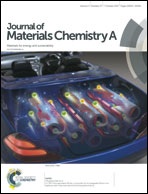Insights into the stable layered structure of a Li-rich cathode material for lithium-ion batteries†
Abstract
Li-rich layered metal oxides (LNMO) receive significant attention as cathode materials of lithium-ion batteries owing to their higher specific energy density and lower cost compared with current commercial cathode materials. However, the stability of the structure during the cycle becomes a fatal weakness. In order to reduce the collapse of the structure during the cycle, previous researchers usually use cationic doping means, but all reported works have ignored the adverse effects from the destruction of the oxide layers that damages the structural integrity of the materials. In this work, from the perspective of a stable oxygen layer structure, we first dope sulfur into the oxygen layers of a lithium-rich cathode material to improve the structural stability and cycling performance. The preliminary calculation results of VASP prove that a small amount of sulfur doping is beneficial to stabilize the crystal structure of the material and balance the energy of the embedding and deintercalation of lithium ions, which provides theoretical guidance for our study. Further electrochemical results show that the sulfur-doped lithium-rich material released a higher initial efficiency of 96%, a specific capacity of 293.3 mA h g−1, and better cycling stability and rate performance (a capacity of 117 mA h g−1 is maintained at a current density of 5C). This work provides a new manner of doping for developing Li-rich layered metal oxide cathode materials that evade structural change.



 Please wait while we load your content...
Please wait while we load your content...